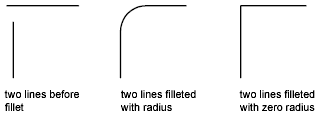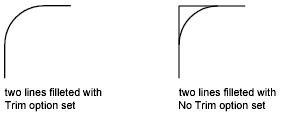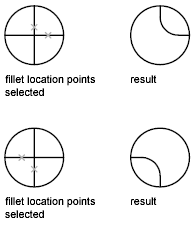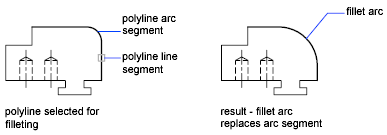A fillet connects two objects with an arc that is tangent to the objects and has a specified radius.

An inside corner is called a fillet and an outside corner is called a round; you can create both using the FILLET command.
You can fillet
FILLET can be used to round all corners on a polyline using a single command.
If both objects being filleted are on the same layer, the fillet arc is created on that layer. Otherwise, the fillet arc is created on the current layer. The layer affects object properties including color and linetype.
Use the Multiple option to fillet more than one set of objects without leaving the command.
The fillet radius is the radius of the arc that connects filleted objects. Changing the fillet radius affects subsequent fillets. If you set the fillet radius to 0, filleted objects are trimmed or extended until they intersect, but no arc is created.

You can hold down SHIFT while selecting the objects to override the current fillet radius with a value of 0.
Trim and Extend Filleted Objects
You can use the Trim option to specify whether the selected objects are trimmed or extended to the endpoints of the resulting arc or left unchanged.

Control the Location of the Fillet
Depending on the locations you specify, more than one possible fillet can exist between the selected objects. Compare the selection locations and resulting fillets in the illustrations.

Fillet Line and Polyline Combinations
To fillet lines with polylines, each line or its extension must intersect one of the polyline line segments. If the Trim option is on, the filleted objects and the fillet arc join to form a single new polyline.

You can fillet an entire polyline or remove fillets from an entire polyline.
If you set a nonzero fillet radius, FILLET inserts fillet arcs at the vertex of each polyline segment that is long enough to accommodate the fillet radius.

If two polyline line segments converge as they approach an arc segment that separates them, FILLET removes the arc segment and replaces it with a fillet arc.

If you set the fillet radius to 0, no fillet arcs are inserted. If two polyline line segments are separated by one arc segment, FILLET removes that arc and extends the lines until they intersect.
You can fillet parallel lines, xlines, and rays. The current fillet radius temporarily adjusts to create an arc that is tangent to both objects and located in the plane common to both objects.
The first selected object must be a line or a ray, but the second object can be a line, an xline, or a ray. The fillet arc connects as shown in the illustration.

Fillet Objects with Non-Zero Thickness in 3D
You can fillet coplanar objects with extrusion directions not parallel to the Z axis of the current UCS. FILLET determines the extrusion direction for the fillet arc in 3D space closest to the direction of the Z axis of the current UCS.